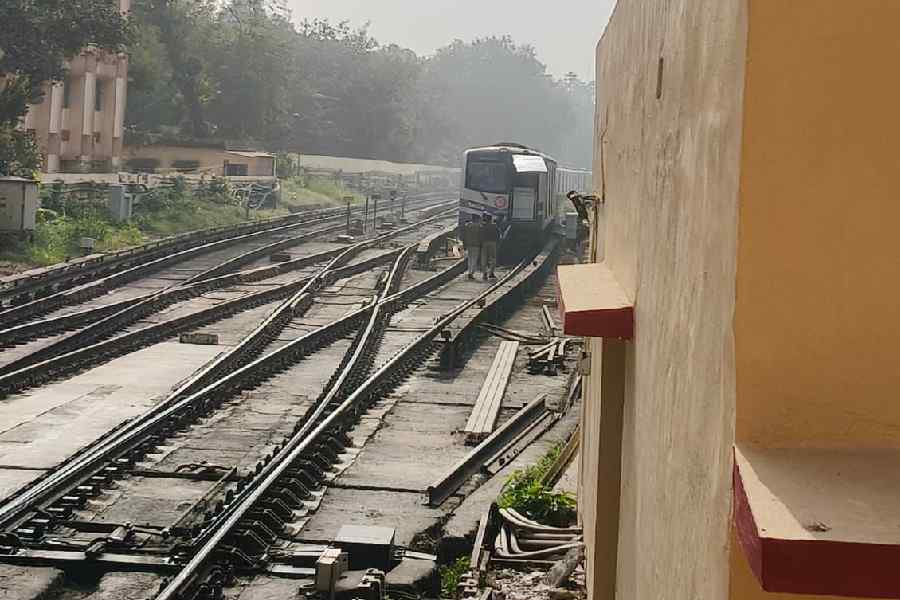|
|
Nimish Adani still wonders how he managed to think straight after a three-hour-long thrashing session. “I was slapped, pushed and hit with lathis. My spectacles were crushed,” says the 26-year-old business development manager at the Bangalore-based Information Technology firm, Logix Microsystems.
Adani had gone to the Bangalore City railway station to see off his fianc?e and her mother, who were returning to Jhansi by the Karnataka Express, on September 30 this year. On his way out, the ticket-collector (TC) asked him for his platform ticket. “He snatched away my ticket and said, ‘What if I say you didn’t buy one?’ ” he recalls.
Before he knew it, Adani was pushed into a small room and beaten by seven men in railway uniforms. “I was abused for being a non-Kannadiga. They made me touch everybody’s feet and beg for pardon. Bruised and bleeding, I was dragged from platform one to six. No one came to help,” says Adani.
The one who finally did, Adani believes, was in league with his assailants. He identified himself as a software engineer with Infosys and told Adani he’d have to pay his way out of the spot. “He asked for my ATM card and withdrew Rs 15,000 from my account. It was only later that I realised he had pocketed all the cash,” says Adani. Thinking on his feet, Adani snatched the money from the man’s pocket and fled.
The young techie believes he was a victim of greed. “The incident happened on the last day of the month ? when most organisations credit salaries into their employees’ accounts. Since I was dressed in formal clothes and had my identity card around my neck, I might have been targeted,” he says.
Greed’s just one reason why Bangalore is on the boil. Last week, a 28-year-old employee of Hewlett-Packard Global Delivery Application Services, Pratibha Srikanth Murthy, was killed by a man who posed as her office cab driver. The accused, Shiva Kumar, told her he was to ferry her to work as the regular route driver was unavailable. It was past midnight when he drove Murthy to an isolated spot on the city’s outskirts and raped, robbed and killed her.
The incident sent shock waves through the city. Hundreds of call centre employees took to the streets to protest the murder. “It’s common to hear of IT professionals being robbed of cellphones and credit cards. But Murthy’s murder is the last straw. I don’t feel safe in Bangalore any more,” says a woman employee of AOL’s Bangalore-based business processing outfit (BPO).
The police, in turn, held a meeting with IT and BPO companies to discuss crime-curbing measures. Some 400 company representatives showed up. “Women employees working night shifts were the focus of the discussion, as they are the softest target,” says Bangalore’s Joint Commissioner of Police, Crime, Narayan Gowda.
The brain-storming session didn’t come a day too soon. The crime rate is soaring in the information technology (IT) city. Bangalore registered 28,000 crime cases in 2005 ? up from 16,002 in 2004. “A 75 per cent jump in crime rate is phenomenal,” says sociologist Anand Inbannathan at the Institute for Social and Economic Change, Bangalore.
Compare these with crime figures in Delhi ? the unofficially crowned crime capital of India. Delhi registered 47,404 crime cases in 2003 and 53,623 cases in 2004 ? that’s a 13 per cent increase in one year. Explains Narayan Gowda, “A growing city will have a high crime rate. More people have higher disposable incomes. It’s easy to get at them.”
Software professionals seem to be at the receiving end of the city’s crime radar. A string of incidents of IT and BPO employees being waylaid on roads and robbed of cash, cars and cellphones rocked Bangalore early this year. “More than a dozen crimes were reported in two months,” says Gowda.
It took a gory murder to get the police into action. In April this year, Rakesh Gupta, an employee of Bangalore-based Tayana Software Solutions, was waiting outside his office to catch a bus back home. A car stopped to offer him a lift. Gupta’s body was later recovered from a gunny bag dumped outside the city. The cops said he was looted and killed.
Following this incident, the police issued a public statement asking IT professionals not to wear their identity cards around their necks outside office. “It makes them easy to spot,” says Gowda.
The ID cards are gone, but the fear remains. “When we get off the office bus at night, we always walk home in groups,” says a software developer who works with Infosys.
Just a day before Murthy was killed, a National Association of Software and Services Companies-McKinsey report released in Bangalore had brought cheer to the IT industry. It announced that the Indian ITES industry had ballooned from $4 billion in 2000 to $17 billion in 2005.
Happy figures. But clearly, the IT boom has its winners and losers. For Bangalore is a word not just for financial success, but growing discontentment as well. A survey conducted this year by a city-based B-school, Alliance Business Academy (ABA), found that unemployment has grown by 18 per cent in the low-income group since 2000. “Bangalore’s growth is focused solely around the software sector. As a result, other segments have lost out,” says G.R. Narayanan, professor, ABA.
The rapid growth of IT in the city has thrown up its own contradictions. A study by the Karnataka Planning Department last year found the incidence of poverty more acute in urban than in rural areas in the state. Though the state’s urban population is 31 per cent, urbanpoor make up 39 per cent of the poor population.
Contradictions abound in Bangalore, where two worlds exist in one time zone. Shikaripalya, a slum village that shares borders with Electronic City ? Bangalore’s technology hub ? would not look so scrawny were it not for the shiny, steel-and-glass Wipro office a 100 yards away. The American and Japanese flags flying outside the Wipro building speak a first world language, but the muddy, garbage-heaped village down the road is a picture in contrast.
ABA’s Narayanan says Bangalore can be split into three different cities. North Bangalore ? with sprawling, tree-lined colonies like Malleshwaram ? once used to be the heart of the city. In the 1960s, the government constructed low income housing colonies such as Majestic and Rajajinagar to accommodate migrant labour population. When IT companies set up shop in the city, the focus shifted to south Bangalore. Electronic City and the International Technology Park Limited were built here ? followed by up-market residential enclaves, malls and hotels. “All jobs are now in south Bangalore. When people from other parts come here to work, they see a glitzy, developed world that they are not a part of. This leads to envy and frustration,” says Narayanan.
Lopsided development has sharply aggravated social inequality in the city. While real estate builders frantically construct western-style villas and residential enclaves with swimming pools and tennis courts for the US-returned, dollar-toting techies, 35 per cent of the city’s population lives in slums. “About 400 slums dot the city,” says Samuel Paul, chairman, Public Affairs Centre (PAC), a city-based NGO.
When the IT and BPO industry came to Bangalore, the traditional south Indian city did a cultural volte face. Women started working at night. Loose stories about the easy sex life of BPO workers began spreading. “These rumours sometimes make people assume that everything is easy and fun. It leads to increasing crime against women,” says Rajiv Gowda, professor, Indian Institute of Management (IIM), Bangalore.
Bangalore’s cash-rich image lures a large floating population from neighbouring states. “They commit crimes and cross the border. It’s difficult to nab them,” says Gowda. He says that 30 per cent of the criminals arrested this year were outsiders to the city.
Another growing segment of offenders arrested by the police is the youth. Last week, the Bangalore Police released figures saying that an average of 2,000 youth ? in the age group of 17 to 25 years ? had been annually nabbed for petty offences in the last three years. The crimes committed included cellphone and chain snatching, house break-ins, picking pockets and car thefts. “Most of them are unemployed,” says Gowda. “Others see high-spending avenues in the city and want to make easy money,” he adds. During counselling sessions, the police found that the youth took to crime either to buy branded clothes or to eat out at expensive restaurants.
Outsiders make perfect targets for crime. Bangalore’s explosive growth ? the city’s population has doubled in the last five years ? has brought in a migrant population that makes sitting-duck victims for crime.
“Committing crimes against outsiders is much easier,” says PAC’s Paul. “They don’t have roots in the city. They don’t know the local language. They don’t have a support system in the city.”
Narayan Gowda agrees. He gives the example of the growing incidence of crimes committed by auto rickshaw drivers. “They follow a standard formula. They make a call from their mobile phone and speak in Kannada. If the passenger doesn’t understand the language, they drive off into a dark alley and rob him at knife-point,” he says. The crime thrives on the premise that outsiders are not aware of the topography of the city and wouldn’t know when they are driven off in a different direction.
The city’s police force has not kept pace with its growth. “While Bangalore has become a 24/7 city, the police force remains the same. You can never spot a cop on the roads at night,” says Surya Siryam, HR head, Spheris, a Bangalore-based medical transcription firm. The police blames it on manpower shortage. At present, the police has a strength of 7,000. A police station has one motorcycle and every two stations share one jeep. “We have asked for an additional force of 10,000 men. The government is still mulling over the proposal,” says Gowda.
But Nimish Adani will tell you that more police officials don’t always mean security or justice. He withdrew his case after spending hours in the police station, sitting through identification parades. No one was booked.
His assailants continue to roam the streets of Bangalore. And Adani still looks back in fear every time he hears a noise behind him.












